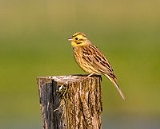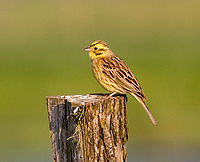
Long-legged Bunting
Encyclopedia
The Long-legged Bunting (Emberiza alcoveri) is an extinct
flightless
species of bunting
. It was distinguishable by its long legs and short wings, and it inhabited the Canary Islands
. It is one of the few flightless Passerine
s known to science, all of which are extinct.
 This bunting belongs to the Emberiza
This bunting belongs to the Emberiza
genus, and is closest related to the Cabanis's Bunting
(E. cabanisi) and the Yellowhammer
(E. citrinella). Emberiza is a genus inside the Bunting family, Emberizidae, which is made up of small, seed-eating birds with distinctive bill shapes. The species name, alcoveri, is in honor of J. A. Alcover, who contributed to fossil fauna knowledge and information.
of the Long-legged Bunting is a partial skeleton. Seven other associated skeletons were found. The bones are held at the University of La Laguna
, in Tenerife, Spain. This species was distinguishable from other buntings as it was larger than existing Emberiza species and had longer legs, shorter wings, and a differently-shaped bill. These features indicate that the Long-legged Bunting was a ground dweller and likely flightless. This makes it one of the few known flightless Passerine
s known, the others being the Stephens Island Wren
(Xenicus lyalli) and the Long-billed Wren
(Dendroscansor decurvirostris). Both of these wrens are extinct. This bunting probably was omnivorous, like the other species in its genus. It likely ate seed
s and invertebrate
s. However, because of its differently-shaped bill, harder seeds could have been included in its diet.
. Bones from this species have only been found in the volcanic cave Cueva del Viento, on the island of Tenerife
. Other species that lived alongside this bunting include various birds, mammals, and lizards. This species likely lived in the Laurel forest
or the transition forest, as food would be plentiful and the herb layer would protect against aerial predators.
. Humans arrived over 2,000 years ago, bringing with them invasive species
such as goat
s, pig
s, cat
s, and sheep. The Europeans impacted the land even more when they arrived, introducing rat
s to the islands and cultivating the land. The Long-legged Bunting was driven to extinction because of these invasive species and the destruction of their habitat.
Extinction
In biology and ecology, extinction is the end of an organism or of a group of organisms , normally a species. The moment of extinction is generally considered to be the death of the last individual of the species, although the capacity to breed and recover may have been lost before this point...
flightless
Flightless bird
Flightless birds are birds which lack the ability to fly, relying instead on their ability to run or swim. They are thought to have evolved from flying ancestors. There are about forty species in existence today, the best known being the ostrich, emu, cassowary, rhea, kiwi, and penguin...
species of bunting
Bunting (bird)
Buntings are a group of Eurasian and African passerine birds of the family Emberizidae.They are seed-eating birds with stubby, conical bills, and are the Old World equivalents of the species known in North America as sparrows...
. It was distinguishable by its long legs and short wings, and it inhabited the Canary Islands
Canary Islands
The Canary Islands , also known as the Canaries , is a Spanish archipelago located just off the northwest coast of mainland Africa, 100 km west of the border between Morocco and the Western Sahara. The Canaries are a Spanish autonomous community and an outermost region of the European Union...
. It is one of the few flightless Passerine
Passerine
A passerine is a bird of the order Passeriformes, which includes more than half of all bird species. Sometimes known as perching birds or, less accurately, as songbirds, the passerines form one of the most diverse terrestrial vertebrate orders: with over 5,000 identified species, it has roughly...
s known to science, all of which are extinct.
Taxonomy

Emberiza
Emberiza is a genus of passerine birds of the bunting family Emberizidae.-List of species:* Yellowhammer, Emberiza citrinella* Pine Bunting, Emberiza leucocephalos* Cirl Bunting Emberiza cirlus* Tibetan Bunting, Emberiza koslowi...
genus, and is closest related to the Cabanis's Bunting
Cabanis's Bunting
The Cabanis's Bunting is a species of bird in the Emberizidae family.It is found in Angola, Burkina Faso, Cameroon, Central African Republic, Chad, Republic of the Congo, Democratic Republic of the Congo, Ivory Coast, Equatorial Guinea, Gabon, Ghana, Guinea, Liberia, Malawi, Mali, Mozambique,...
(E. cabanisi) and the Yellowhammer
Yellowhammer
The Yellowhammer, Emberiza citrinella, is a passerine bird in the bunting family Emberizidae. It is common in all sorts of open areas with some scrub or trees and form small flocks in winter....
(E. citrinella). Emberiza is a genus inside the Bunting family, Emberizidae, which is made up of small, seed-eating birds with distinctive bill shapes. The species name, alcoveri, is in honor of J. A. Alcover, who contributed to fossil fauna knowledge and information.
Description
The holotypeHolotype
A holotype is a single physical example of an organism, known to have been used when the species was formally described. It is either the single such physical example or one of several such, but explicitly designated as the holotype...
of the Long-legged Bunting is a partial skeleton. Seven other associated skeletons were found. The bones are held at the University of La Laguna
University of La Laguna
The University of San Fernando de La Laguna, also known as the ULL is situated in San Cristóbal de La Laguna, on the island of Tenerife. It is the oldest university in the Canary Islands, and has the highest student population of any university in these islands. It is also considered the most...
, in Tenerife, Spain. This species was distinguishable from other buntings as it was larger than existing Emberiza species and had longer legs, shorter wings, and a differently-shaped bill. These features indicate that the Long-legged Bunting was a ground dweller and likely flightless. This makes it one of the few known flightless Passerine
Passerine
A passerine is a bird of the order Passeriformes, which includes more than half of all bird species. Sometimes known as perching birds or, less accurately, as songbirds, the passerines form one of the most diverse terrestrial vertebrate orders: with over 5,000 identified species, it has roughly...
s known, the others being the Stephens Island Wren
Stephens Island Wren
The Stephens Island Wren or Lyall's Wren was a nocturnal, flightless, insectivorous passerine.-Habitat:...
(Xenicus lyalli) and the Long-billed Wren
Long-billed Wren (New Zealand)
The Long-billed Wren was a species of New Zealand wren endemic to the South Island of New Zealand. It was the only species in the genus Dendroscansor...
(Dendroscansor decurvirostris). Both of these wrens are extinct. This bunting probably was omnivorous, like the other species in its genus. It likely ate seed
Seed
A seed is a small embryonic plant enclosed in a covering called the seed coat, usually with some stored food. It is the product of the ripened ovule of gymnosperm and angiosperm plants which occurs after fertilization and some growth within the mother plant...
s and invertebrate
Invertebrate
An invertebrate is an animal without a backbone. The group includes 97% of all animal species – all animals except those in the chordate subphylum Vertebrata .Invertebrates form a paraphyletic group...
s. However, because of its differently-shaped bill, harder seeds could have been included in its diet.
Distribution and habitat
The Long-legged Bunting was a native of the Canary IslandsCanary Islands
The Canary Islands , also known as the Canaries , is a Spanish archipelago located just off the northwest coast of mainland Africa, 100 km west of the border between Morocco and the Western Sahara. The Canaries are a Spanish autonomous community and an outermost region of the European Union...
. Bones from this species have only been found in the volcanic cave Cueva del Viento, on the island of Tenerife
Tenerife
Tenerife is the largest and most populous island of the seven Canary Islands, it is also the most populated island of Spain, with a land area of 2,034.38 km² and 906,854 inhabitants, 43% of the total population of the Canary Islands. About five million tourists visit Tenerife each year, the...
. Other species that lived alongside this bunting include various birds, mammals, and lizards. This species likely lived in the Laurel forest
Laurel forest
Laurel forest is a subtropical or mild temperate forest, found in areas with high humidity and relatively stable and mild temperatures. They are characterized by tree species with evergreen, glossy, enlongated leaves, known as laurophyll or lauroide...
or the transition forest, as food would be plentiful and the herb layer would protect against aerial predators.
Extinction
The Long-legged Bunting had lived in the Canary Islands during the Upper Pleistocene to the HoloceneHolocene
The Holocene is a geological epoch which began at the end of the Pleistocene and continues to the present. The Holocene is part of the Quaternary period. Its name comes from the Greek words and , meaning "entirely recent"...
. Humans arrived over 2,000 years ago, bringing with them invasive species
Invasive species
"Invasive species", or invasive exotics, is a nomenclature term and categorization phrase used for flora and fauna, and for specific restoration-preservation processes in native habitats, with several definitions....
such as goat
Goat
The domestic goat is a subspecies of goat domesticated from the wild goat of southwest Asia and Eastern Europe. The goat is a member of the Bovidae family and is closely related to the sheep as both are in the goat-antelope subfamily Caprinae. There are over three hundred distinct breeds of...
s, pig
Pig
A pig is any of the animals in the genus Sus, within the Suidae family of even-toed ungulates. Pigs include the domestic pig, its ancestor the wild boar, and several other wild relatives...
s, cat
Cat
The cat , also known as the domestic cat or housecat to distinguish it from other felids and felines, is a small, usually furry, domesticated, carnivorous mammal that is valued by humans for its companionship and for its ability to hunt vermin and household pests...
s, and sheep. The Europeans impacted the land even more when they arrived, introducing rat
Rat
Rats are various medium-sized, long-tailed rodents of the superfamily Muroidea. "True rats" are members of the genus Rattus, the most important of which to humans are the black rat, Rattus rattus, and the brown rat, Rattus norvegicus...
s to the islands and cultivating the land. The Long-legged Bunting was driven to extinction because of these invasive species and the destruction of their habitat.

